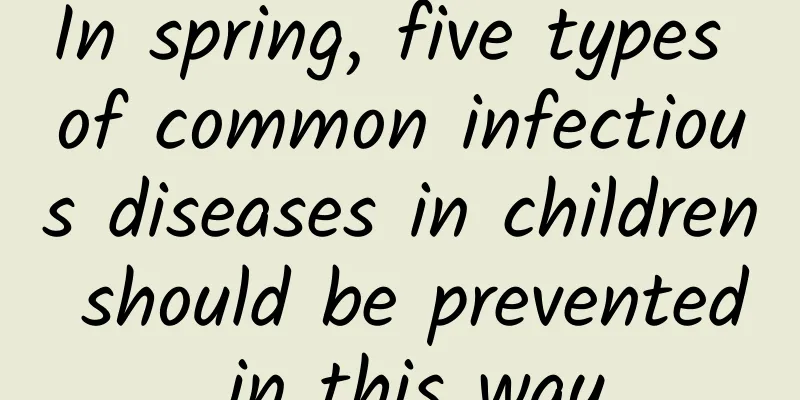In spring, five types of common infectious diseases in children should be prevented in this way

|
In spring, everything comes back to life and the sun is shining brightly. Pathogens also begin to stir and wait for opportunities to strike. Facing a new world, children can't contain their excitement. But how can we protect children from infectious diseases? Be wary of these 5 infectious diseases influenza Influenza is an acute respiratory infectious disease caused by influenza virus. It is transmitted through respiratory droplets and can also be indirectly transmitted through objects contaminated by the virus. It is highly contagious and spreads rapidly. Children infected with influenza mainly show symptoms such as fever, headache, myalgia, fatigue, and cough. They are contagious from 1 to 7 days after onset of the disease, and are most contagious in the first 2 to 3 days of the disease. Many parents have trouble telling the difference between the flu and the common cold. The following symptoms can help you tell the difference. Common cold: Most symptoms are mild, including sneezing, runny nose, dry and sore throat, low fever or no fever, which can be relieved naturally in 3 to 5 days. Influenza: It often has an acute onset and high fever, with body temperature as high as 39℃~40℃, often accompanied by chills, headache, back pain, muscle and joint pain, fatigue, sore throat, cough, etc. Some children may have digestive tract manifestations such as nausea, abdominal pain, diarrhea, and abdominal distension. Uncomplicated influenza fever generally lasts for 3 to 4 days, and systemic discomfort symptoms are alleviated after the fever subsides, but dry cough and fatigue may last for 1 to 2 weeks. Compared with the common cold, influenza is more prone to complications, and very few severe cases can lead to death. chicken pox Chickenpox is an acute infectious disease caused by varicella-zoster virus infection. The high-risk age is 1 to 14 years old. Chickenpox patients are the only source of infection for this virus. Patients are contagious from 1 to 2 days before the onset of the disease until the rash dries and scabs. After the human body is infected with the varicella virus, the disease occurs after an incubation period of about 2 weeks. Children may experience symptoms such as fever, headache, general discomfort, and decreased appetite, and a rash will appear within 24 hours of onset. The rash is distributed centripetally, that is, the most on the trunk, followed by the head and face, and less on the limbs. The skin lesions show an evolution process from small red maculopapular rashes → herpes → scabs → scabbing, and no scars are left after scabbing. There is obvious pain and itching during the herpes period. If secondary infection occurs after scratching, mild dents may be left. Chickenpox generally does not cause serious complications, but some children may develop encephalitis in the later stages of the disease, so the child's condition should be closely observed and symptomatic treatment should be actively given. Mumps The age of mumps is 5 to 15 years old, and it is common in winter and spring. Mumps is transmitted through direct contact or inhalation of droplets and saliva, and the disease occurs 2 to 3 weeks after contact with the patient. The main characteristics of children are unilateral facial swelling and pain, which is generally centered on the earlobe and develops forward, backward, and downward with unclear edges. The local skin of the face is tense, shiny but not red, tough and elastic to the touch, and slightly tender. The patient's mouth will cause the pain to worsen. Usually, swelling of one side of the parotid gland will affect the contralateral parotid gland 1 to 4 days after swelling, and about 75% of children have bilateral swelling. Parotid swelling reaches its peak in 3 to 5 days and gradually subsides in 7 to 10 days. Some patients may have symptoms such as fever, chills, sore throat, and general discomfort. Severe cases may be accompanied by complications such as viral encephalitis, orchitis, pancreatitis, oophoritis, myocarditis, etc. A few patients have hearing loss. Scarlet fever Scarlet fever is an acute respiratory infectious disease caused by infection with group A beta streptococci. The general population is susceptible, and it is more common in children over 3 years old, with a high incidence age of 5 to 15 years old. It is mainly transmitted through respiratory droplets. The incubation period after infection is 1 to 7 days. Most children show acute onset, chills, fever, and in severe cases, the body temperature can rise to 39℃~40℃, accompanied by symptoms such as sore throat, headache, loss of appetite, nausea, vomiting, and general discomfort. Children develop a rash within 24 hours of onset, starting behind the ears, neck, and upper chest, and can spread to the whole body within a day. The typical rash is a scarlet diffuse maculopapular rash on the basis of skin congestion. The skin turns white when pressed, and the congestion returns within a few seconds after decompression. The rash usually disappears within 1 week, and peeling of varying degrees begins from the end of the 1st week to the second week, presenting as rice bran-like desquamation or large-scale peeling. Children with scarlet fever may also have some special signs: ① The face is congested and flushed, but there is no rash, and the area around the mouth and the tip of the nose appear pale, which is called the circumoral pallor sign. ② The tongue papillae are red and swollen, protruding like bright red bayberries, which is called bayberry tongue. ③ In the skin folds, such as the armpits, elbows, groin, etc., the rash can be seen densely packed in linear shapes, which are called "Pa's lines". A very small number of children have serious conditions, with symptoms such as high fever, convulsions, coma, and even shock, and sometimes may suffer from complications such as myocarditis, pneumonia, nephritis, and rheumatic fever. measles Measles is a highly contagious acute respiratory infectious disease caused by the measles virus, and the general population is susceptible. More than 90% of people who have not been vaccinated against measles will develop the disease after being exposed to the measles virus. With the widespread vaccination of measles vaccines, the incidence rate has now dropped significantly, and the age of onset has tended to shift later, with older children and young adults being more common than infants and young children. Measles patients are the only source of infection, and the virus is mainly transmitted through droplets or direct contact with the patient's secretions. The incubation period after infection is 9 to 14 days, and patients are contagious from 2 to 4 days before the onset of the disease to 5 days after the rash appears. The initial symptoms of the patient are similar to those of a cold, including fever, cough, sneezing, runny nose, conjunctivitis, eyelid edema, photophobia and tearing. At this time, the rash has not yet appeared and it is easy to be mistaken for influenza. Before the rash appears, white or blue-white spots (Koplik spots) appear on the buccal mucosa in the patient's mouth, which are characteristic. Once the rash appears, the spots disappear quickly. The typical rash first begins to appear on the hairline, the sides of the neck, and behind the ears, and spreads to the face, neck, upper limbs and upper chest within about 24 hours, and then spreads downward to the trunk, lower limbs and palms and soles, and can merge into pieces. This is when the disease is most serious. 3 to 5 days after the rash appears, the patient's body temperature begins to drop. If the patient continues to have a high temperature, it indicates complications such as pneumonia and encephalitis. To deal with infectious diseases, good protection is the key Spring is a season of high susceptibility to infectious diseases. In fact, as long as you take proper precautions, there is no need to panic. To deal with infectious diseases, we recommend doing the following in your daily life: 01 Families with conditions should turn on air purifiers, ultraviolet disinfection and other equipment regularly every day. Families with limited conditions should ventilate each room 2 to 3 times a day (morning, noon and evening). Choose convection windows to facilitate air circulation, and open the windows for ventilation for 30 to 60 minutes each time. At the same time, clean the home environment frequently and dry clothes and quilts frequently to prevent viruses and bacteria from hiding. 02 Wash your hands carefully with hand sanitizer before meals, after defecation, and after going out. Caregivers should also wash their hands before contacting children, when changing diapers for young children, and after handling feces, and properly dispose of waste. When you go out, you can carry hand sanitizer containing 75% alcohol or disposable hand towels to disinfect your hands. 03 Develop good hygiene habits and do not spit anywhere. Personal items such as towels, toothbrushes, and tableware should be disinfected regularly. 04 Maintain good living habits and exercise regularly. The climate in spring is changeable, so you should add or remove clothes according to the weather changes. As the saying goes, early to bed and early to rise is good for your health. Don't stay up late, rest on time, and ensure adequate sleep to ensure your immunity. 05 Ensure adequate nutrition and a balanced diet every day, eat high-protein foods, fresh and clean vegetables and fruits appropriately. All foods must be fully cooked before consumption, do not be partial or picky about food, properly match meat and vegetables, and pay attention to nutritional matching. 06Vaccination is the main link in preventing various infectious diseases. Vaccines are the best means to prevent the occurrence of various infectious diseases and should be completed on time. 07 If symptoms of the above infectious diseases appear, seek medical attention as soon as possible and receive standardized diagnosis and treatment. |
Recommend
Have you heard of these new methods for preventing and treating allergic diseases? Professor Cheng Lei shares
Allergic reaction is defined as the body's in...
Want surgery to remove eye bags? Then you must know these precautions!
Eye bags, dark circles and other eye skin problem...
Summary of clinical experience in using bronchial occluders
Bronchial occluders are now playing an increasing...
Fetal excretion pathway
During pregnancy, pregnant mothers will definitel...
Causes of bacterial vaginitis
Bacterial vaginitis is also a type of vaginitis. ...
How to deal with vaginal itching during pregnancy
Pregnancy is a great test for women's lives, ...
Can I eat comfrey during menstruation?
Many female friends have no problems normally, bu...
Eating 1 pack of nuts a day for 3 months and being diagnosed with high blood lipids? It is best not to buy these two kinds of nuts!
When it comes to nuts, I think many people will t...
What to do if gynecological diseases are serious during pregnancy?
Many women's body resistance decreases after ...
In this case, don't rush to get glasses.
School has started, and some children occasionall...
How to remove the odor of leucorrhea
In the hot summer, it is the peak period for bact...
Is there any scientific basis for the saying “diseases come from the mouth”?
"Diseases come from the mouth" is somet...
What should I do if my face is covered with acne during pregnancy?
Many pregnant women will develop acne on their fa...
Endometriosis Diet Therapy
Endometriosis is a disease that troubles many wom...
How much weight can you lose during confinement?
Women will gain weight quickly during the confine...









